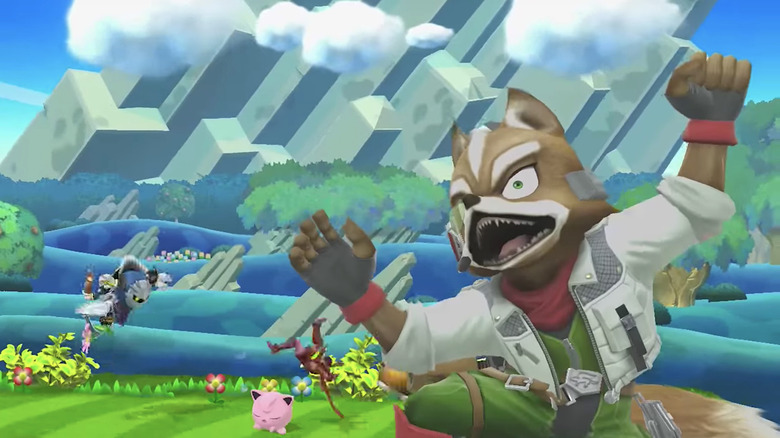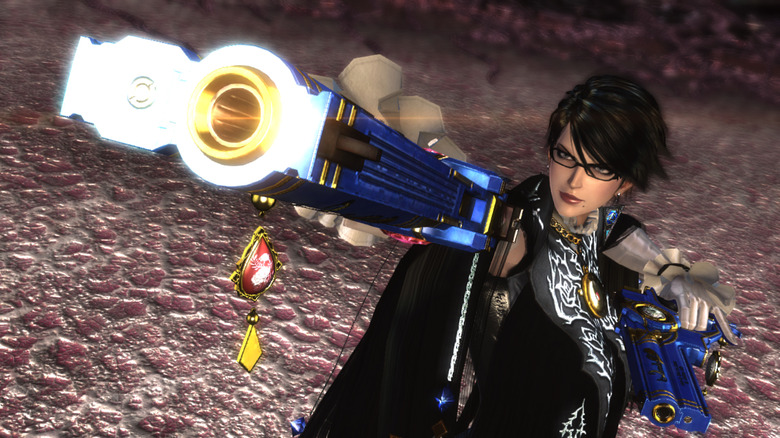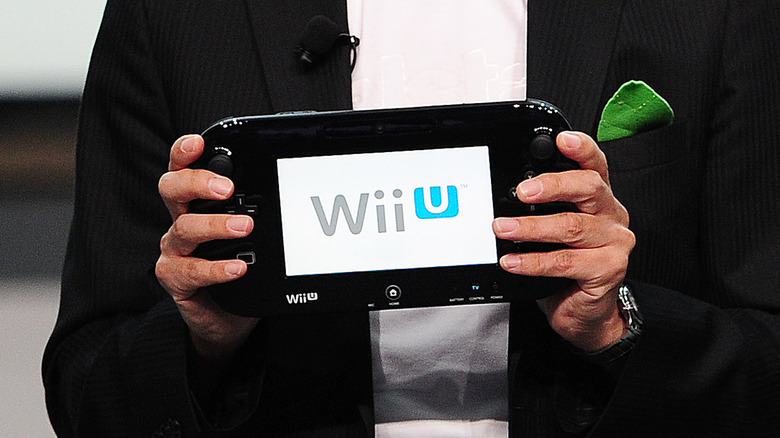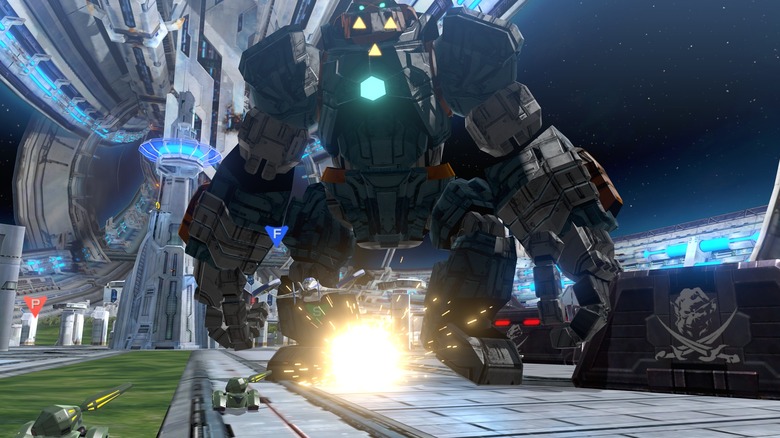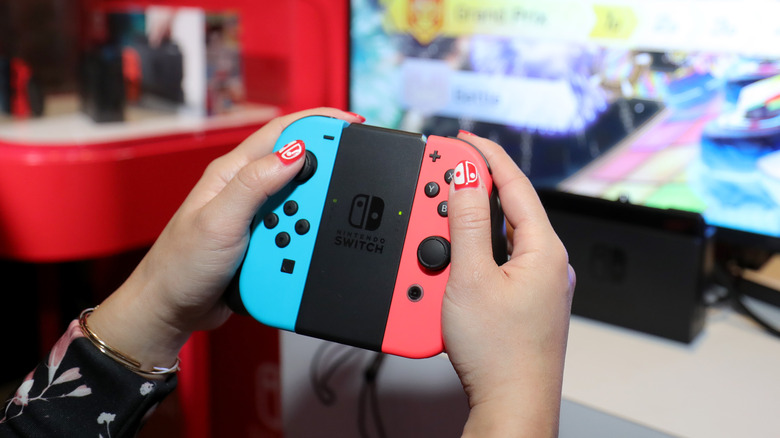Why The Wii U Flopped
Since the release of the Nintendo Entertainment System, or NES, in 1983, Nintendo has enjoyed a firm hold on its own little corner of the gaming market. The Japanese video game company continued to impress both gamers and critics alike in the years since its 8-bit phenomenon with the SNES, N64, and GameCube consoles. With the motion control-based Wii, which dropped in 2006, Nintendo revolutionized gaming once again and proved that they were still a creative force to be reckoned with.
Unfortunately, even the biggest names in video games bomb every once in a while — and Nintendo dropped the ball when they followed up the successful Wii with the underperforming Wii U. Despite promising first impressions, crystal clear HD graphics, and a dedicated fanbase, the system just never took off the way that Nintendo's previous efforts did. But what exactly toppled the video game juggernaut? Let's take a closer look at why the Wii U flopped so hard.
Alienating audiences
Nintendo consoles aren't exactly known for catering to hardcore gamers: y'know, the "git gud" crowd. On the contrary, the Wii, arguably Nintendo's most accessible gaming platform, was marketed almost exclusively to casual gamers and audiences who'd never played video games before, like the elderly. When it came time to determine a target demographic for the Wii U, however, Nintendo pulled a total 180 and made it their mission to appeal to hardcore gamers.
In June 2012, Gamespot reported that Nintendo's then-Executive VP of Sales and Marketing Scott Moffitt claimed the company sought to appeal to hardcore gamers. Moffitt stated, "[Hardcore gamers are] very much part of our audience and the group of consumers we hope will find the way you can reimagine games on the Wii U." He topped this off with an awfully grandiose delusion, musing, " ... the Wii U could become the preferred way to play those games for some of the core gamers." Katsuya Eguchi, deputy general manager at Nintendo Entertainment Planning & Development, echoed Moffitt's ambitions, stating, " ... with the Wii U, we hope that the players who were introduced to gaming for the first time on the Wii will step it up and become core gamers themselves."
Unfortunately, things didn't pan out the way Nintendo had planned. The Wii U didn't appeal to casual gamers the way the Wii did, and the console's limited options and lackluster technical capabilities alienated the hardcore gamers Nintendo aimed to attract.
Third-party perils
From Mario and Pikachu to Link and Samus Aran, Nintendo's fan favorite characters are amongst gaming's most iconic figures. The brand's emphasis on first-party franchises like Super Mario Bros. and Metroid has benefited Nintendo in the past — just ask Xbox head honcho Phil Spencer. But gamers cannot live by The Legend of Zelda alone, and when that itch for something fresh and different comes along, Nintendo might not be the best brand to scratch it. While this issue has never really hurt Nintendo before, it spelled doom for the Wii U right out of the gate.
The sad truth is that the Wii U's less-than-stellar third-party support may not have even posed a problem if Nintendo had pushed outside developers to back its consoles — specifically, the Wii — earlier on. Back in September 2010, GamesIndustry reported that late Nintendo boss Satoru Iwata acknowledged the Wii's third-party problem. The industry bigwig admitted that third-party titles sold significantly less than in-house developed games, noting, "it is true that the third-party software sales ratio on Nintendo platforms are comparatively smaller in Japan. Wii's third-party software ratio is especially low."
Even though the Wii U loaded its library with games like Assassin's Creed III and Watch Dogs, these titles were pared-down ports from competing consoles, complete with inferior graphics and weird gameplay quirks reliant on the system's funky GamePad. Thus, gamers lucky enough to own multiple consoles likely opted for the superior Xbox and PlayStation versions of these games, reserving their Wii U for Nintendo exclusives.
Pricey pitfalls
Unless you're in the 1%, a video game system isn't exactly an impulse buy. But for all the hours of playtime you'll get from beating up baddies and hunting rare achievements, their price tags are often more or less reasonable. The same can't be said for the ill-fated Wii U. Not only was it Nintendo's most expensive console to date at launch, tying the later Switch at a whopping $300, but Japanese gamers unlucky enough to break their GamePads had to dish out another 13,824 yen — roughly $108 — for a replacement. Keep in mind: that was the price of a GamePad in 2015. Kotaku reported that, in 2012, they cost an unbelievable 13,440 yen (roughly $172), or, to put that in perspective, almost half the cost of the entire console! Western gamers had it worse, if you can believe it. Nintendo refused to sell individual GamePads in North America at launch, and they were suspiciously tight-lipped about how much it would cost to repair the units.
For example: say you busted your GamePad duking it out with an especially tough demon in Bayonetta 2. And, say, per instructions, you contacted Nintendo for an estimate. Based on gamers' testimonials, getting your GamePad back in working shape — or nabbing a replacement via proper channels — would set you back anywhere from $50 to over $100. That ain't chump change! It was, however, incentive enough for some gamers to avoid the Wii U like the plague.
Tablet tech troubles
When Nintendo debuted the Wii way back in November 2006, its combo controller — a motion control-based remote and "nunchuk" peripheral — was met with near-unanimous praise. It was gimmicky, sure, but it introduced a new, innovative input for gamers of all ages to play and made mincemeat of the Xbox 360 and PS3 in terms of sales. So when Nintendo realized that they needed to come up with a brand new way to revolutionize console gaming, they opted for something a little different: touchscreen technology. Unfortunately, for all of Nintendo's innovations, they couldn't predict the rise of tablets — or the fact that other companies would beat them to the portable punch.
In an interview with NPR's Laura Sydell, Mario creator and acting Representative Director of Nintendo Shigeru Miyamoto addressed the Wii U's biggest hurdle (and its ensuing faceplant). Miyamoto told Sydell, "I think unfortunately what ended up happening was that tablets themselves appeared in the marketplace and evolved very, very rapidly, and unfortunately the [Wii U] system launched at a time where the uniqueness of those features were perhaps not as strong as they were when we had first begun developing them."
Simply comparing the Wii U's GamePad to your typical tablet device is proof enough that Shigeru's statements ring true. Between its bulky frame and low-res screen — not to mention its short signal range and unimpressive battery life — gamers assuming that their Wii U came with a complimentary tablet must've been sorely disappointed.
Star Fox snafu
But it wasn't just the tech specs that turned gamers off of the Wii U's GamePad — nor was it the fact that the clunky thing looked more like a Sega Game Gear than something manufactured in the 21st century. The final nail in the doomed console's coffin turned out to be its GamePad integration. Despite being one of its early selling points, the system's bizarre touchscreen controller never felt essential to gameplay. Sure, games like Splatoon and Fatal Frame: Maiden of Black Water put its motion control capabilities to use, but the former let players disable the GamePad's gyroscopic controls, and — let's face it — who even played Fatal Frame?
The Wii U rarely forced players to actually use their GamePads for something other than scrolling through menus or clicking map markers. But when it did, the result was not pretty.
Take, for instance, 2016's Star Fox Zero, a game celebrated by Shigeru Miyamoto himself for taking full advantage of the Wii U's hardware. We could've gotten an exciting, fast-paced shoot-em-up that took players through the Lylat star system and beyond. Instead, what we got was, as controversial game critic Jim Sterling put it, " ... a bare-bones space shooter utilizing a deliberately obtuse control scheme in order to mask the fact it's nowhere near as interesting as it pretends to be." Needless to say, Sterling wasn't alone — critics panned the game's gyroscopic controls, and the majority felt that Nintendo was trying to breathe new life into a console that had already given up the ghost.
Marketing mishaps
Protip: When your consumer base has no idea what you're trying to sell them, chances are you're not advertising it right. But Nintendo must've missed that memo when they put together their press junkets for the Wii U. Even after its infamously perplexing E3 2011 reveal, nobody knew what the heck a "Wii U" was. Some gamers assumed it was a new console. Others guessed that it was a bizarre add-on to the beloved Wii. Still, judging from the video shown at E3 — and the repeated use of the word "controller" — many reasonably hypothesized that it was just that: a newfangled touchscreen controller. Following Nintendo's official unveiling, the questions persisted: why did it support so many controllers? What was that big, honkin' tablet the guy from the video presentation was playing? Was that the Wii U itself? Or was that its controller?
The answer? A big, baffling "yes" to all of the above.
To this day, gamers consider the Wii U the most confusing console ever released. Maybe that's because the Wii, which succeeded thanks in part to its a "pick up and play" vibe, was so simple by comparison. Or maybe it's because nobody — including retailers like Target, apparently — understood it. And when you need article upon article explaining what your complex console is (and what it isn't), then maybe it's time to accept defeat and start planning for the future.
Switching things up
But, sometimes, planning for the future means looking back at past victories. When Nintendo released the Switch in March 2017, the hybrid handheld/home console defied all expectation — much like the Wii did when it captured hearts over a decade earlier. The Switch outsold the Wii U in just ten months and reminded players why they'd fallen in love with Nintendo in the first place. The system was truly portable, since you could take it anywhere — compared to the Wii U's GamePad, which had a signal range of only a few dozen feet. Plus, it came with two built-in "Joy-Con" controllers, meaning couch multiplayer was more convenient than ever. The Switch proved that Nintendo still had a few tricks up its sleeve, none of which would've been possible if the Wii U hadn't crashed and burned so awesomely.
Talking to CNN, Nintendo of America boss Reggie Fils-Aimé admitted that the company had learned a lot from screwing up the Wii U's marketing. As a result, he said, "[Nintendo] worked hard for the Nintendo Switch to make it crystal clear what the proposition is. It's a home system that you can take on the go, play anywhere with anyone, and that's resonating." He also addressed the Wii U's failure to attract third-party developers, confessing, " ... we need [third-party] companies to create content to support us. We have that now with Nintendo Switch." With AAA titles like Skyrim and Doom in addition to indie gems like Night in the Woods and Oxenfree in its roster, it looks like the Switch has all its bases covered.

